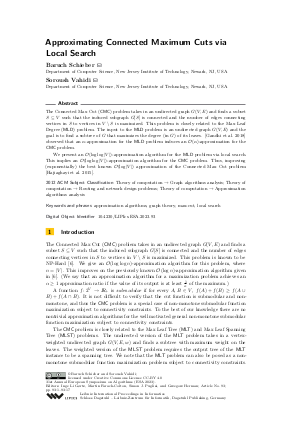Approximating Connected Maximum Cuts via Local Search
Authors Baruch Schieber, Soroush Vahidi
-
Part of:
Volume:
31st Annual European Symposium on Algorithms (ESA 2023)
Part of: Series: Leibniz International Proceedings in Informatics (LIPIcs)
Part of: Conference: European Symposium on Algorithms (ESA) - License:
 Creative Commons Attribution 4.0 International license
Creative Commons Attribution 4.0 International license
- Publication Date: 2023-08-30
File

PDF
LIPIcs.ESA.2023.93.pdf
- Filesize: 0.76 MB
- 17 pages
Document Identifiers
Subject Classification
ACM Subject Classification
- Theory of computation → Graph algorithms analysis
- Theory of computation → Routing and network design problems
- Theory of computation → Approximation algorithms analysis
Keywords
- approximation algorithms
- graph theory
- max-cut
- local search
Metrics
- Access Statistics
-
Total Accesses (updated on a weekly basis)
0PDF Downloads0Metadata Views
Abstract
The Connected Max Cut (CMC) problem takes in an undirected graph G(V,E) and finds a subset S ⊆ V such that the induced subgraph G[S] is connected and the number of edges connecting vertices in S to vertices in V⧵S is maximized. This problem is closely related to the Max Leaf Degree (MLD) problem. The input to the MLD problem is an undirected graph G(V,E) and the goal is to find a subtree of G that maximizes the degree (in G) of its leaves. [Gandhi et al. 2018] observed that an α-approximation for the MLD problem induces an 𝒪(α)-approximation for the CMC problem. We present an 𝒪(log log |V|)-approximation algorithm for the MLD problem via local search. This implies an 𝒪(log log |V|)-approximation algorithm for the CMC problem. Thus, improving (exponentially) the best known 𝒪(log |V|) approximation of the Connected Max Cut problem [Hajiaghayi et al. 2015].
Cite As Get BibTex
Baruch Schieber and Soroush Vahidi. Approximating Connected Maximum Cuts via Local Search. In 31st Annual European Symposium on Algorithms (ESA 2023). Leibniz International Proceedings in Informatics (LIPIcs), Volume 274, pp. 93:1-93:17, Schloss Dagstuhl – Leibniz-Zentrum für Informatik (2023)
https://doi.org/10.4230/LIPIcs.ESA.2023.93
BibTex
@InProceedings{schieber_et_al:LIPIcs.ESA.2023.93,
author = {Schieber, Baruch and Vahidi, Soroush},
title = {{Approximating Connected Maximum Cuts via Local Search}},
booktitle = {31st Annual European Symposium on Algorithms (ESA 2023)},
pages = {93:1--93:17},
series = {Leibniz International Proceedings in Informatics (LIPIcs)},
ISBN = {978-3-95977-295-2},
ISSN = {1868-8969},
year = {2023},
volume = {274},
editor = {G{\o}rtz, Inge Li and Farach-Colton, Martin and Puglisi, Simon J. and Herman, Grzegorz},
publisher = {Schloss Dagstuhl -- Leibniz-Zentrum f{\"u}r Informatik},
address = {Dagstuhl, Germany},
URL = {https://drops.dagstuhl.de/entities/document/10.4230/LIPIcs.ESA.2023.93},
URN = {urn:nbn:de:0030-drops-187466},
doi = {10.4230/LIPIcs.ESA.2023.93},
annote = {Keywords: approximation algorithms, graph theory, max-cut, local search}
}
Author Details
References
-
Francisco Barahona, Martin Grötschel, Michael Jünger, and Gerhard Reinelt. An application of combinatorial optimization to statistical physics and circuit layout design. Oper. Res., 36(3):493-513, 1988.

-
Uriel Feige, Nicole Immorlica, Vahab S. Mirrokni, and Hamid Nazerzadeh. A combinatorial allocation mechanism with penalties for banner advertising. In Proceedings of the 17th International Conference on World Wide Web, WWW 2008, Beijing, China, April 21-25, 2008, pages 169-178, 2008.

-
Pedro F. Felzenszwalb and Daniel P. Huttenlocher. Efficient graph-based image segmentation. Int. J. Comput. Vis., 59(2):167-181, 2004.

-
Rajiv Gandhi, Mohammad Taghi Hajiaghayi, Guy Kortsarz, Manish Purohit, and Kanthi K. Sarpatwar. On maximum leaf trees and connections to connected maximum cut problems. Inf. Process. Lett., 129:31-34, 2018.

-
Mohammad Taghi Hajiaghayi, Guy Kortsarz, Robert MacDavid, Manish Purohit, and Kanthi K. Sarpatwar. Approximation algorithms for connected maximum cut and related problems. In Nikhil Bansal and Irene Finocchi, editors, ESA 2015 - 23rd Annual European Symposium, Patras, Greece, September 14-16, 2015, Proceedings, volume 9294 of Lecture Notes in Computer Science, pages 693-704. Springer, 2015.

-
MohammadTaghi Hajiaghayi, Guy Kortsarz, Robert MacDavid, Manish Purohit, and Kanthi K. Sarpatwar. Approximation algorithms for connected maximum cut and related problems. Theor. Comput. Sci., 814:74-85, 2020.

-
Jason D. Hartline, Vahab S. Mirrokni, and Mukund Sundararajan. Optimal marketing strategies over social networks. In Proceedings of the 17th International Conference on World Wide Web, WWW 2008, Beijing, China, April 21-25, 2008, pages 189-198, 2008.

-
Bart M. P. Jansen. Kernelization for maximum leaf spanning tree with positive vertex weights. J. Graph Algorithms Appl., 16(4):811-846, 2012.

-
Richard M. Karp. Reducibility among combinatorial problems. In Raymond E. Miller and James W. Thatcher, editors, Proceedings of a symposium on the Complexity of Computer Computations, held March 20-22, 1972, at the IBM Thomas J. Watson Research Center, Yorktown Heights, New York, USA, The IBM Research Symposia Series, pages 85-103. Plenum Press, New York, 1972.

-
Jon M. Kleinberg, Christos H. Papadimitriou, and Prabhakar Raghavan. Segmentation problems. J. ACM, 51(2):263-280, 2004.

-
Jon Lee, Viswanath Nagarajan, and Xiangkun Shen. Max-cut under graph constraints. In Integer Programming and Combinatorial Optimization - 18th International Conference, IPCO, Liège, Belgium, June 1-3, 2016, Proceedings, pages 50-62, 2016.

-
Paul Lemke. The maximum leaf spanning tree problem for cubic graphs is NP-Complete. Technical report, University of Minnesota, 1988. Technical report, IMA publication no. 428.

-
Slav Petrov. Image segmentation with maximum cuts, 2005.

-
Alexander Reich. Complexity of the maximum leaf spanning tree problem on planar and regular graphs. Theoretical Computer Science, 626:134-143, 2016.

-
Andreas S. Schulz and Nelson A. Uhan. Approximating the least core value and least core of cooperative games with supermodular costs. Discrete Optimization, 10(2):163-180, 2013.

-
Roberto Solis-Oba. 2-approximation algorithm for finding a spanning tree with maximum number of leaves. In Gianfranco Bilardi, Giuseppe F. Italiano, Andrea Pietracaprina, and Geppino Pucci, editors, Algorithms - ESA '98, 6th Annual European Symposium, Venice, Italy, August 24-26, 1998, Proceedings, volume 1461 of Lecture Notes in Computer Science, pages 441-452. Springer, 1998.

